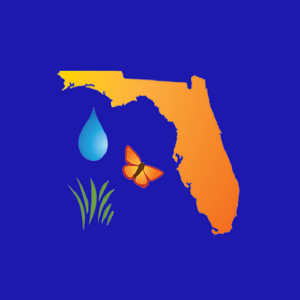What you do in your landscape matters. From the fertilizers you apply, to the water you use, your landscaping practices can potentially have adverse effects on Florida’s land, water, and wildlife. Here in South Florida, we have an especially important role in protecting our water resources, due to our proximity to vulnerable coastal habitats, estuaries, rivers, and even the Biscayne Bay Aquifer–an underground layer of water-bearing limestone that over 4,000,000 Floridians rely on for freshwater.
Now, with Miami-Dade County’s fertilizer ban going into effect this past month (no fertilizers containing Nitrogen or Phosphorous may be applied in Miami-Dade County from May 15 to October 31 due to concerns with storm water runoff –more information here), it seems like there is no better time to discuss the Florida-Friendly Landscaping Program TM and its nine founding principles–specifically the program’s cornerstone principle, “Right Plant, Right Place”. In this blog we will take a look at the importance and benefits of planting landscape plants in the spots they are best suited in order to reduce water, fertilizer, and pesticide needs, and in turn, creating beautiful and sustainable landscapes that save money and help protect Florida’s natural environment.

The Florida-Friendly Landscaping TM Program is the state of Florida’s premier extension program that promotes sustainable alternatives to “conventional” landscaping. Since its inception, it continues to provide guidance on low-impact, environmentally friendly, science-based landscape practices that use less water and reduce pollutant loading into Florida waters, like the Biscayne Bay Aquifer. If you would like to read more about the FFL Program, please visit their website (click here), or read all about a variety of environmental topics on Ask IFAS – a publication search-engine for scholarly articles and research being produced by the University of Florida (Subtopic – Florida Friendly Landscaping).
Achieving a healthy, low-maintenance home landscape starts with putting the right plant in the right place. Essentially, the idea for this principle stems from the fact that plants well-suited to the location where they are installed will survive (and even thrive) with limited additional input. These additional inputs of fertilizers, pesticides, water, etc. on plants grown in ill-suited areas will only add to the potential runoff pollution of a particular site. Factors that determine the proper placement of a specific plant may include the site’s soil, light, water, and climactic conditions, or even the other plants in that area (planting groupings of plants based on shared water and nutrient needs).
A common misconception with the “right plant, right place” principle is that plants must be Florida natives in-order to be Florida-Friendly. In reality, this is not the case at all–as long as they don’t act invasive or require excessive inputs of nutrients and water to grow, a plant can be Florida-Friendly! As a resident of Florida, you should be aware that invasive plants and some non-native plants have potential to offset local plant and wildlife and have no place in the Florida landscape. Not to mention that many times, native alternatives have evolved alongside native Floridian wildlife, and may even be required by certain species for survival–to eat, reproduce, etc.! For this reason, consider offering a diverse selection of native plants in your landscape, as this will increase the likelihood of attracting beneficial insects and animals that will reduce the need to spray harsh chemical pesticides as they defend your plants for you!
One of the most important features when determining the “right plant for the right place” in your specific home landscape is the potential size the plant will reach when it is fully mature. Keeping a plant’s mature size in mind will help reduce the amount of pruning and maintenance required to hold that plant off of structures, potentially causing them harm. Think of pruning your plants as you would a scrape or a cut on your own body – when you trim off a branch of a tree, for instance, you are opening up a wound from which disease and infestation can occur. Thus, the less you are opening up these wounds due to a reduced need to trim the plant, the less stressed the plant will be–needing less water, fertilizer, and pesticides to thrive and be healthy. In turn, reduced needs for these harsh chemicals minimize polluted storm water runoff from getting into our major bodies of water (which would cause a host of issues including algal blooms, fish kills, and more).
New resources make the plant selection process much easier for the average homeowner and also provide knowledge on the water and light requirements, mature size, the ecological benefits a plant may serve for the environment it is planted in (i.e. host plant, nectar plant, food source, etc.), and more! I encourage that everyone take a look at these resources, and into transforming their grass yards into “Florida-Friendly” landscapes–it all starts with planting the right plant in the right place. Take a stand in the fight to protect Florida’s water quality today by reducing the water, fertilizer, and pesticide needs of your landscape. Do not hesitate to contact your local extension office or FFL coordinator if you have any questions or require specific guidance on your quest to achieving a Florida-Friendly yard.
The Florida-Friendly Landscaping Guide to Plant Selection and Landscape Design
Check out these free-to-use applications released by UF/IFAS on your computer, tablet, or smartphone – available on the App Store and Google Play store for Android or Apple.
IRC – Natives for Your Neighborhood
 0
0


